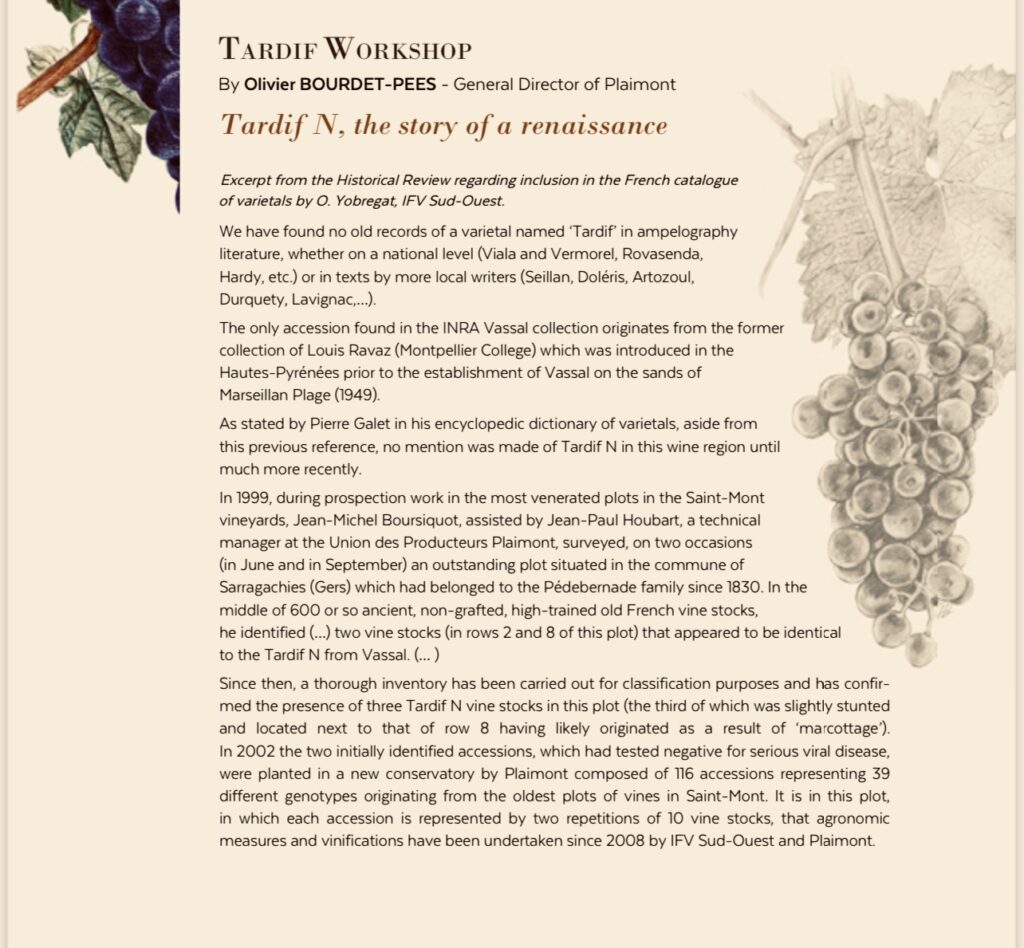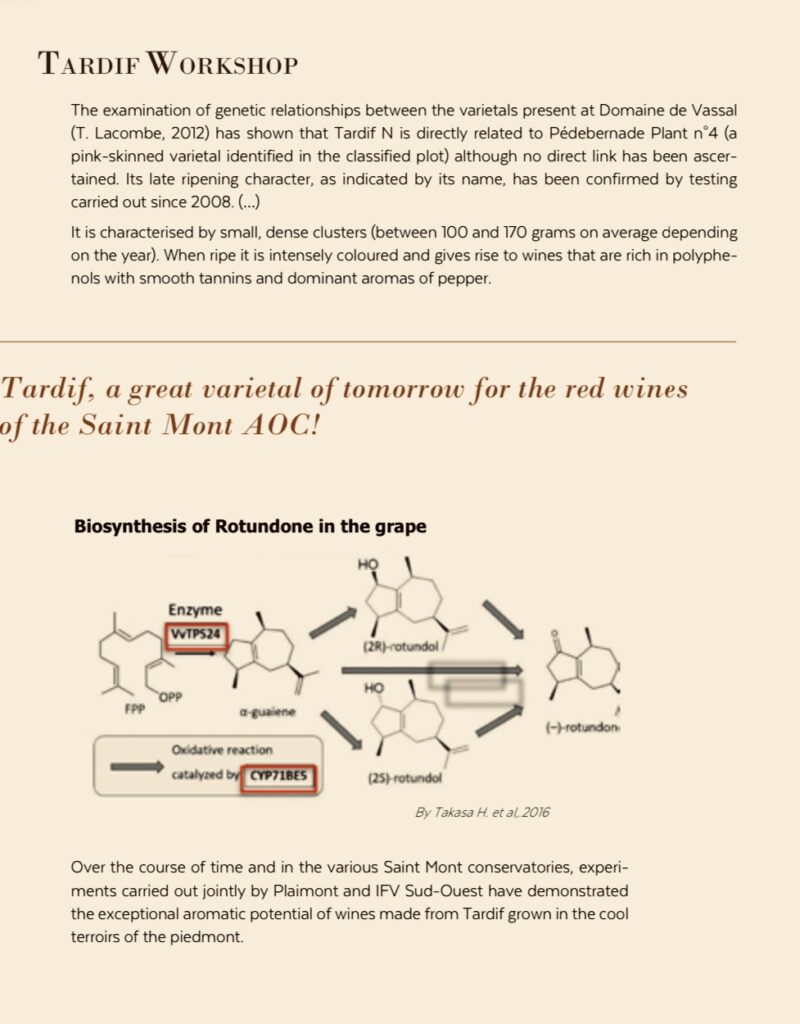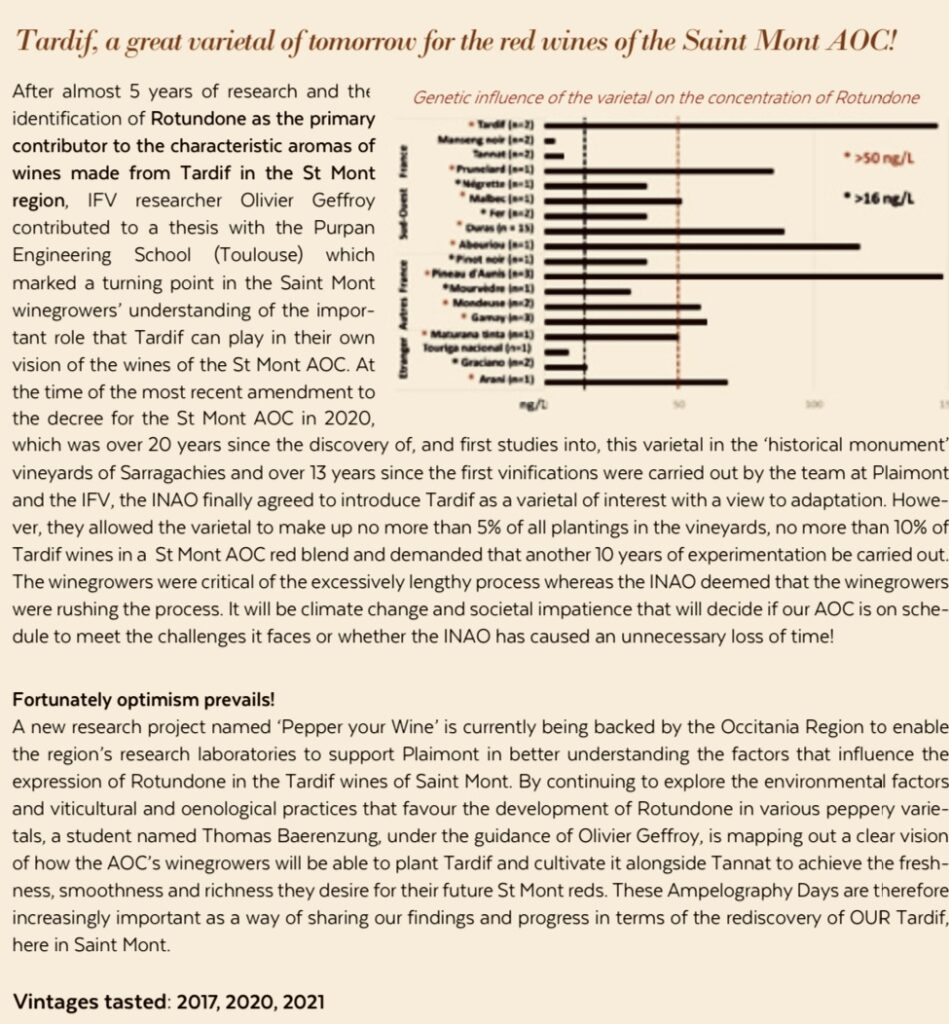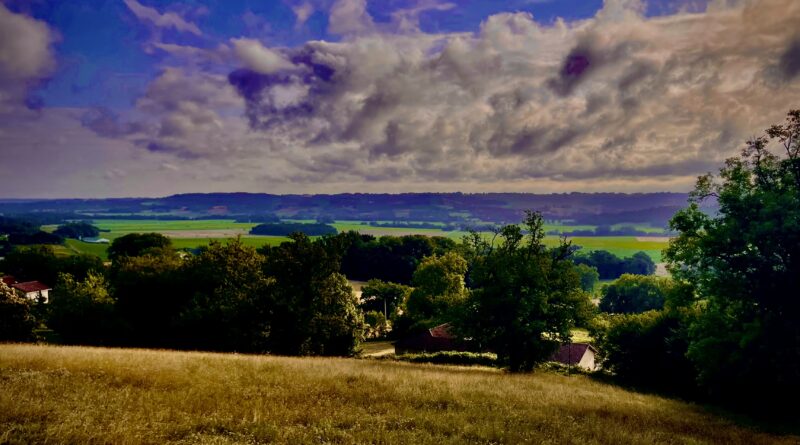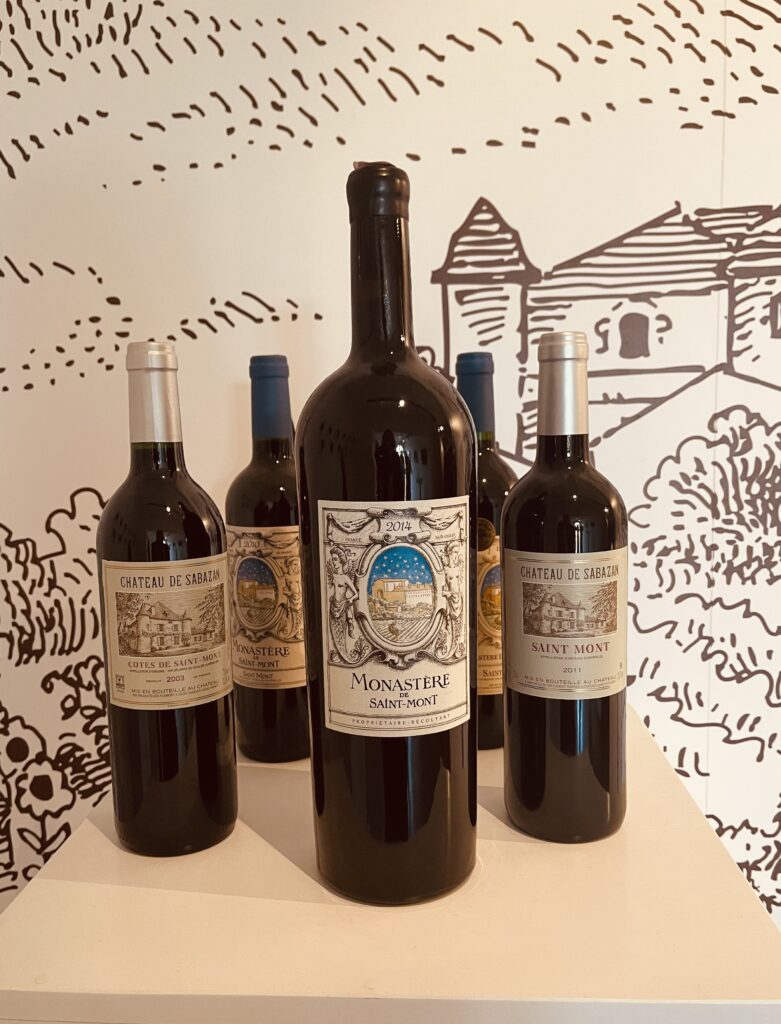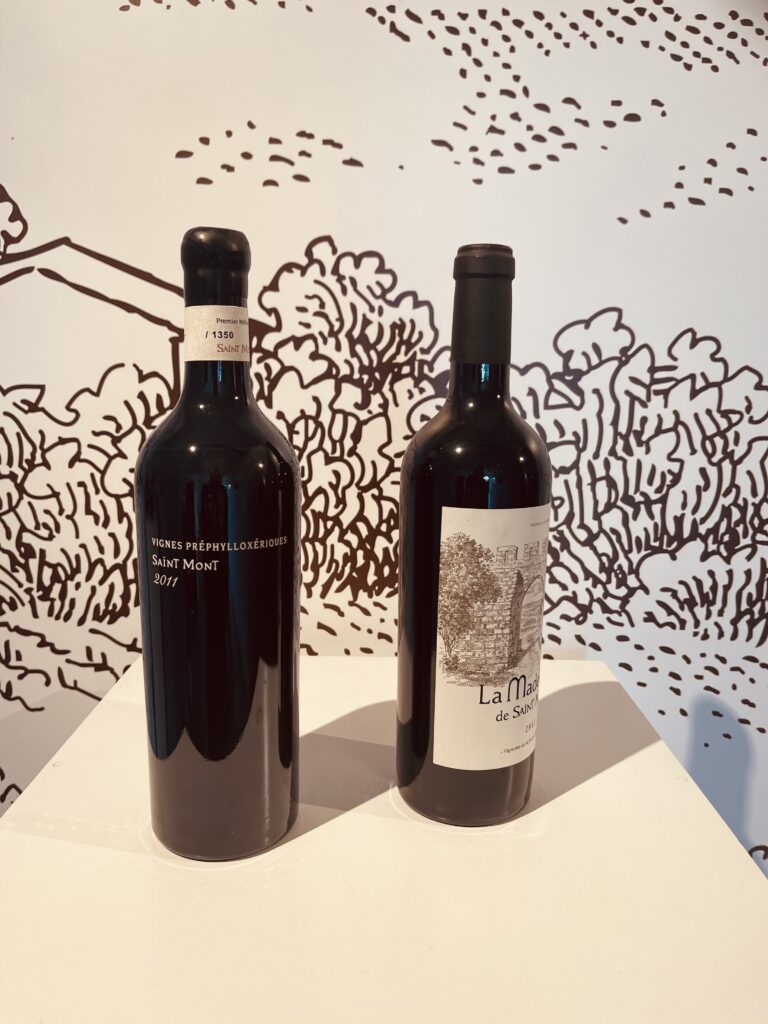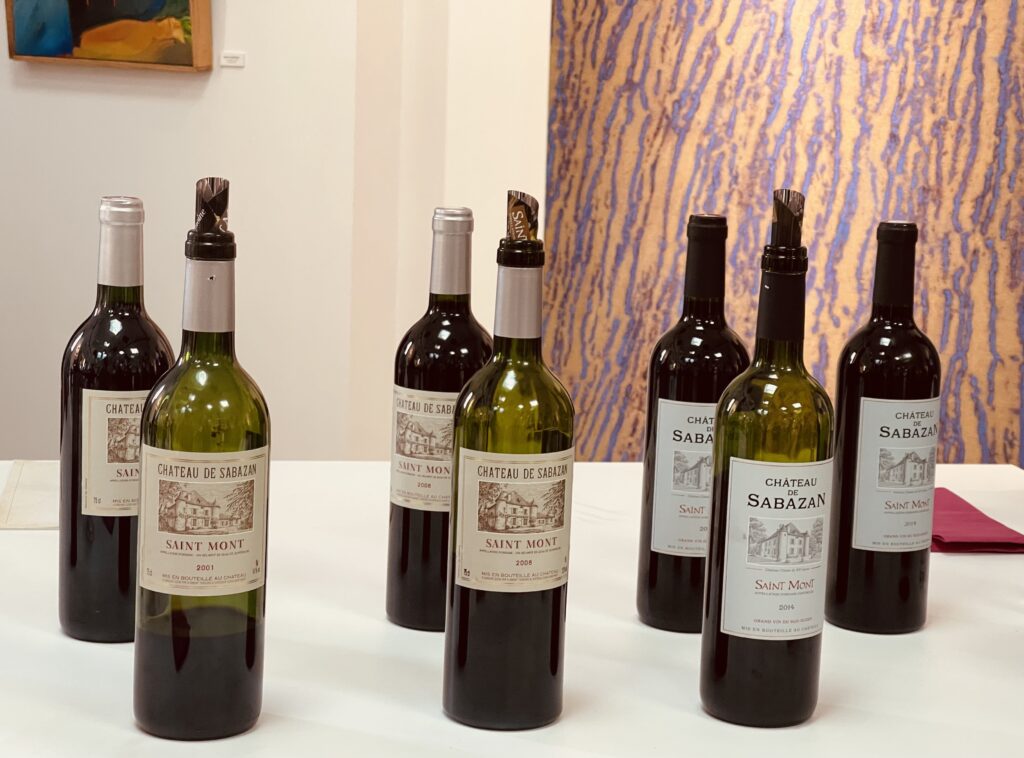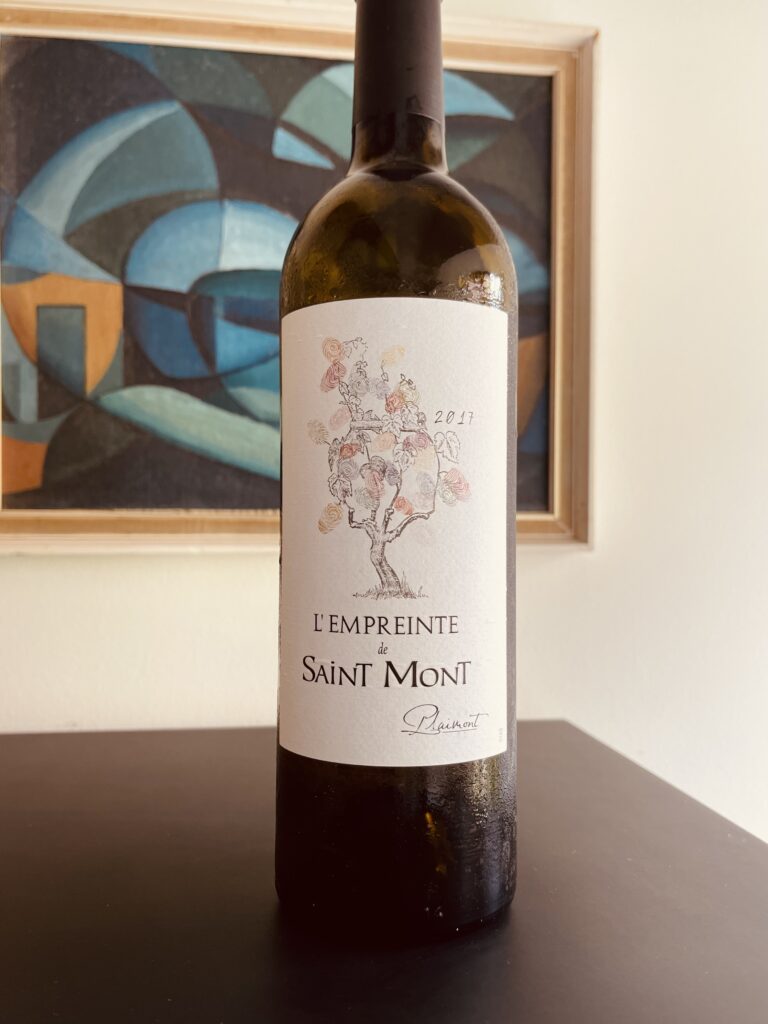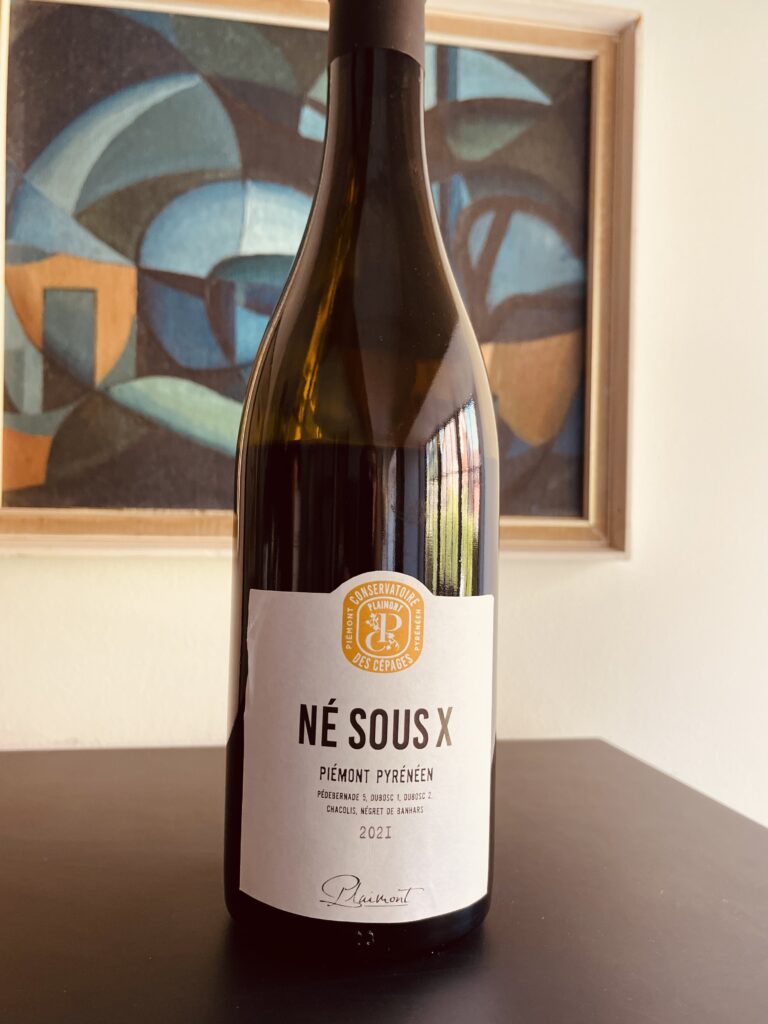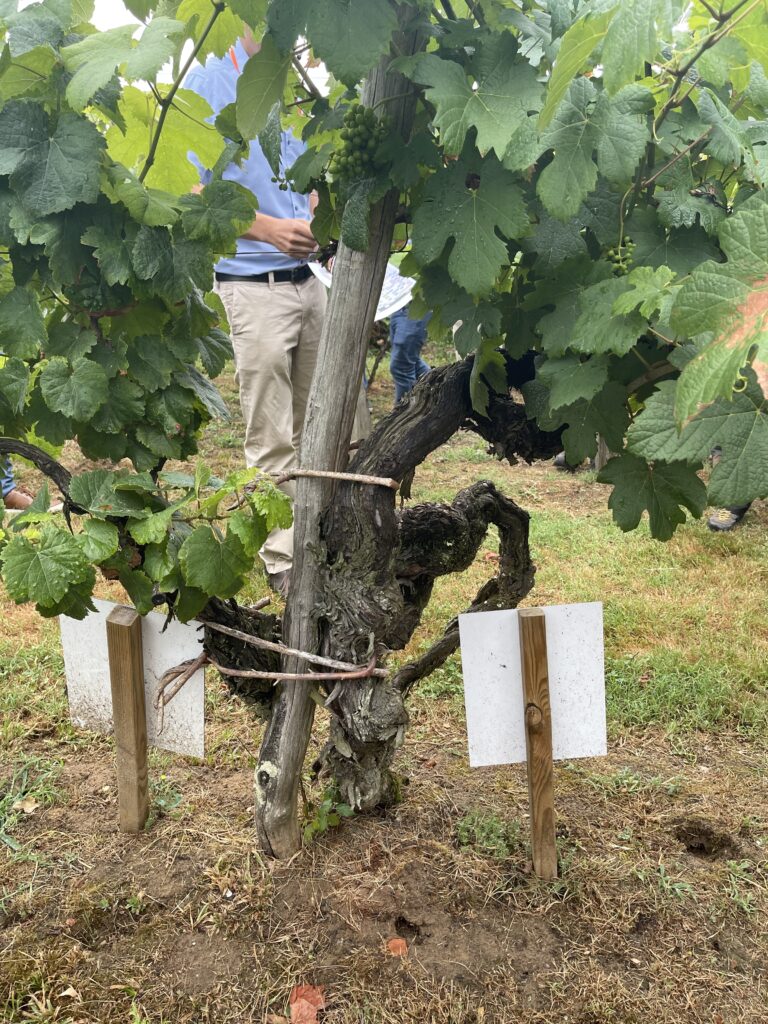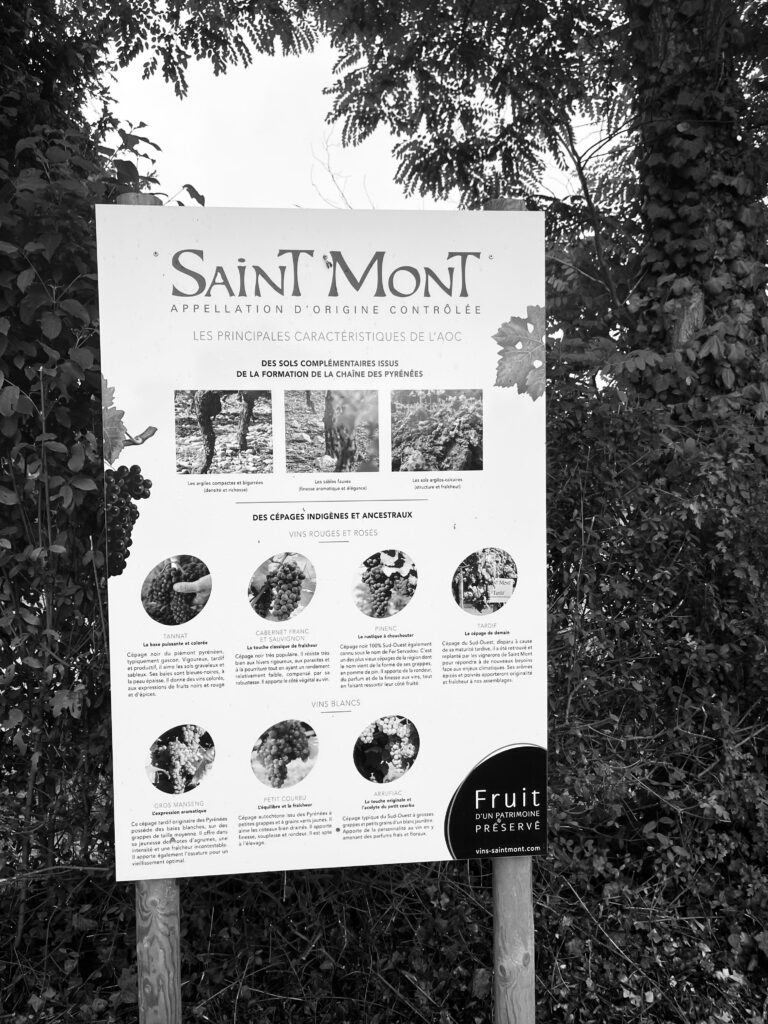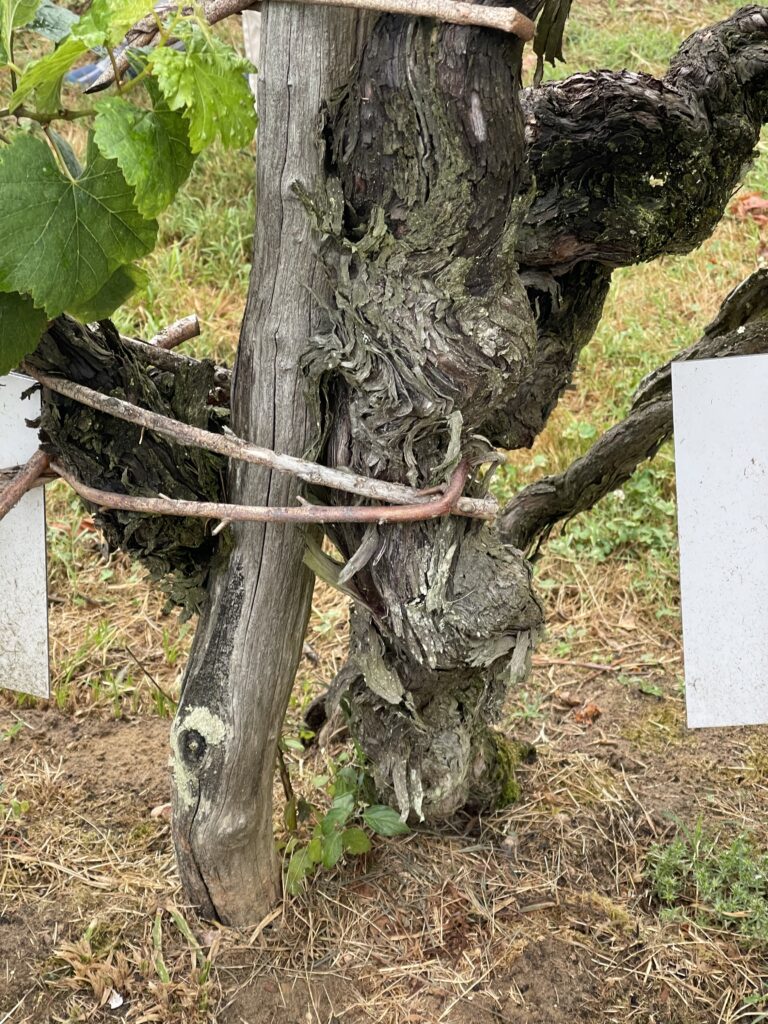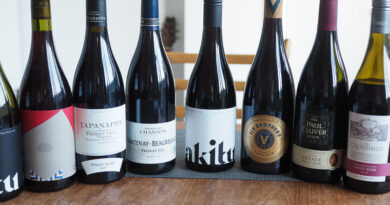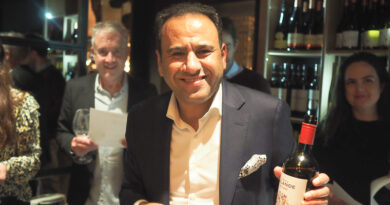Visiting Plaimont, a super-co-op that has changed the face of southwest France
Forty years ago Gascony produced some of the most unloved wines in Europe. Today, the region has Plaimont – a truly radical movement, a centre of research and international debate, as well as a ground-breaking uber co-op. Exciting tangential wines are being produced – and one day they might just help save the wine world from the effects of climate change.
Lisse Garnett reports.
Varieties that fell out of favour for low alcohol levels, late ripening and other reasons lost to the mists of time might well hold the key to future productivity. Plaimont have been seeking out these ancient cultivars for some years now, and growing them to work out how these attributes might serve us in the fight against climate change. Radical ampelographic research accompanied by the group’s acquisition of the region’s best châteaux has enabled this co-op to make giant strides in quality, taste and reputation. They have a created a cohesive wine region and endowed it with a unique identity. By doing this they have earned a chair at a table populated by synchronistic project leaders and maverick thinkers from throughout the wine making world. All this in 40 years.
Gascony has the Pyrénées to the South, the Atlantic Ocean to the West, beautiful verdant rolling rich hills, breath-taking bastides, fields of yellow sunflowers, cows and geese. The region has always practised polycultural farming – olives, Armagnac grapes, cows and foul vie with vines, foie gras ducks, geese and garlic. Ruled by England for 300 years, as was the whole of SW France, it is the land from whence Eleanor of Aquitane and Gascony came – Queen of England from 1137 to 1152. Peppered with pilgrim paths and monasteries, Gascony lies directly on the camino route to Santiago de Compostela.
This long-established agricultural landscape has remained untouched for many centuries – the farmers lived hand to mouth so change simply didn’t happen. A number of pre-phylloxera vineyards have survived here in sandy soils. The Pédebernade family vineyard is an excellent example – ungrafted and containing vines that are the only known surviving plant of their type. These vines may have lost favour for their low productivity, vigour, slow ripening or low levels of alcohol – all things that might confer value in the warmer world of today.
The Pédebernade family vineyard was planted in 1871 and bears witness to pre-phylloxera France. Planted in double vine with a wicker tying method, the plot contains some 21 varieties including a few unidentified ancient whites, Tannat, Tardif (a whole section on this grape is included in the final paragraphs) and Pinenc. A wine made from the Pédebernade family vineyard, Né Sous X 2021 is listed in the tasting notes..
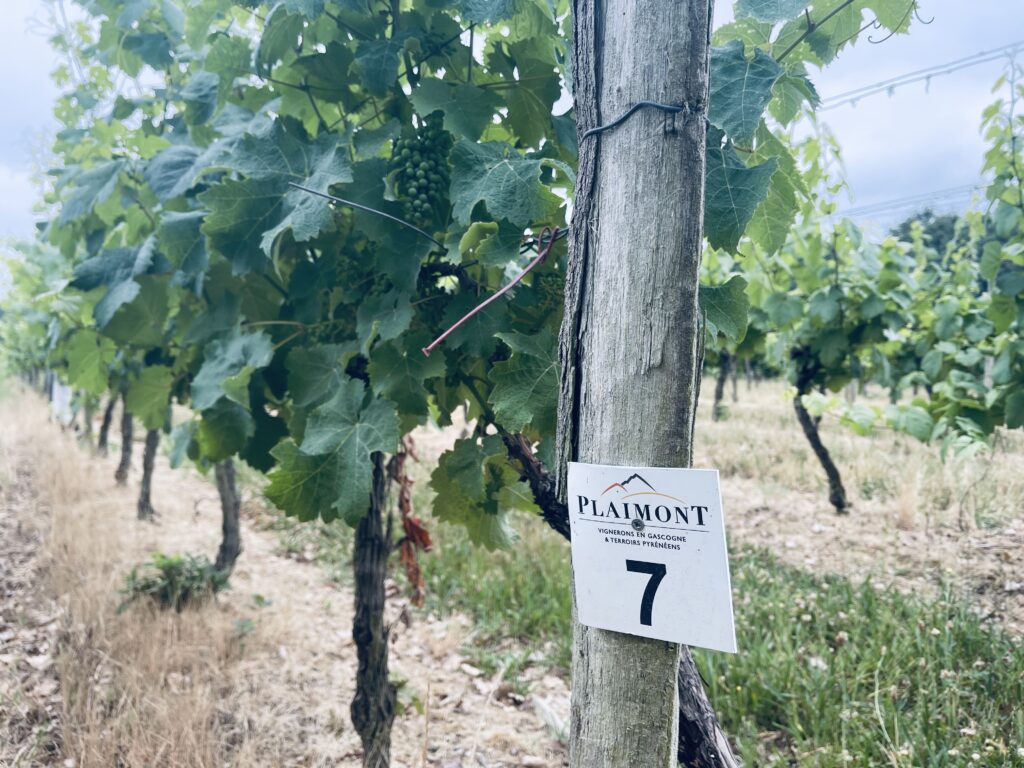
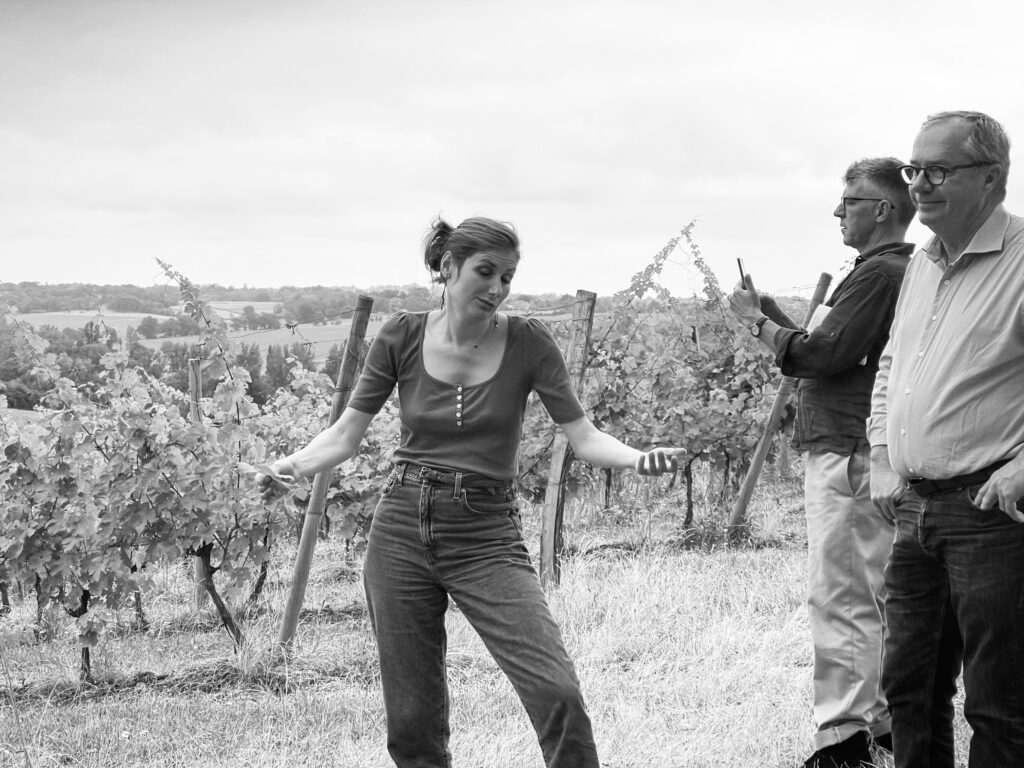
The charismatic Nadine Raymond, Director of the Caves des Vignerons de Saint Mont 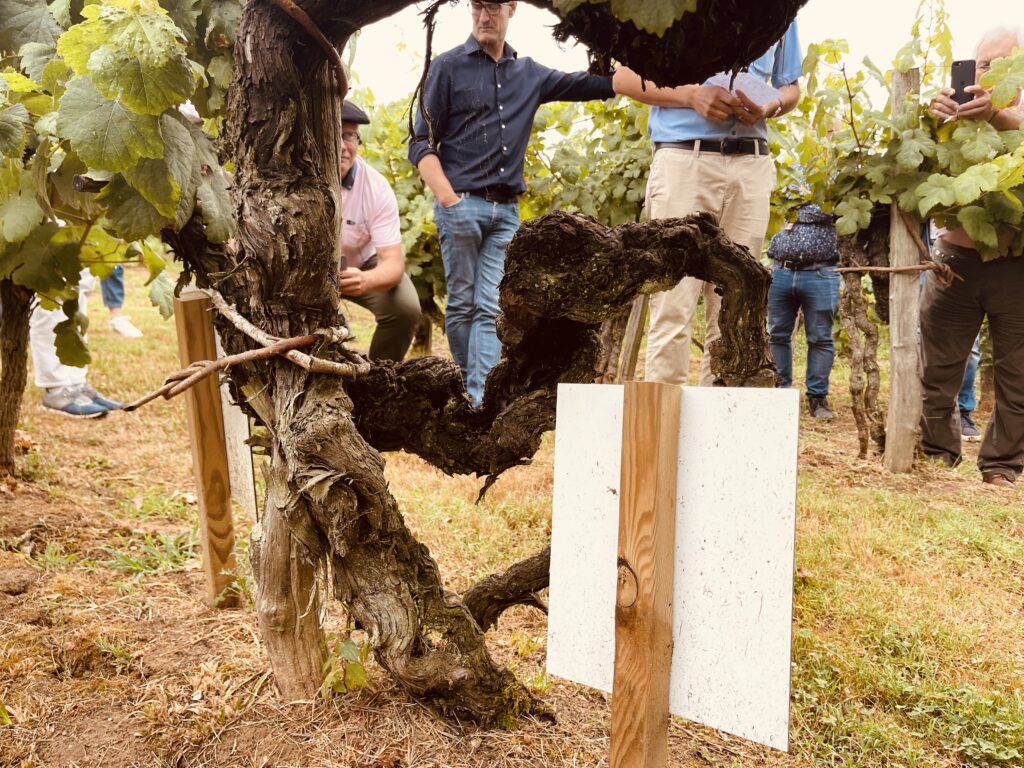
The Pédebernade family vineyard 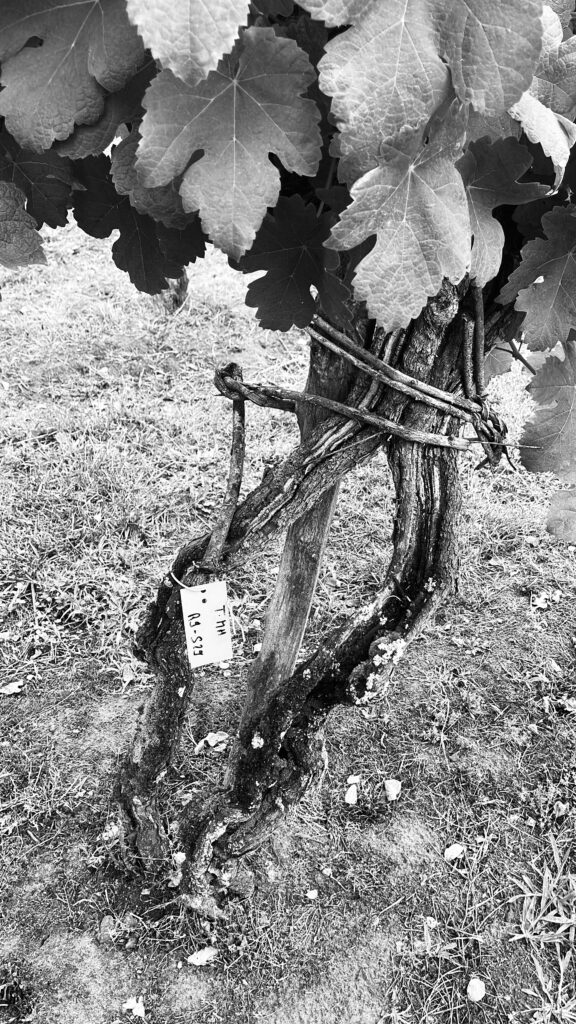
double vine with a wicker tying method
Forty years ago – by their own admission these farmers were producing ‘some of the worst wines in France’ – this was a place the young could not wait to leave. But this was also their strength. Uniquely placed, with nowhere to go but up, the wine producers of the Saint Mont appellation in the southwest of France took a collective chance under the leadership of a beret-wearing revolutionary visionary, their vinous Che Guevara. A modest man, a third-generation farmer, this man was André Debosc. He was already working hard to boost the regions identity with a contemporary range of crisp dry whites. He told the farmers straight – that the regional habit of making wine or Armagnac out of the same grapes needed to stop – they must commit to wine OR Armagnac and they could not make both. This collective decision was to change everything, deciding their strength lay in numbers they united as a Co-op.
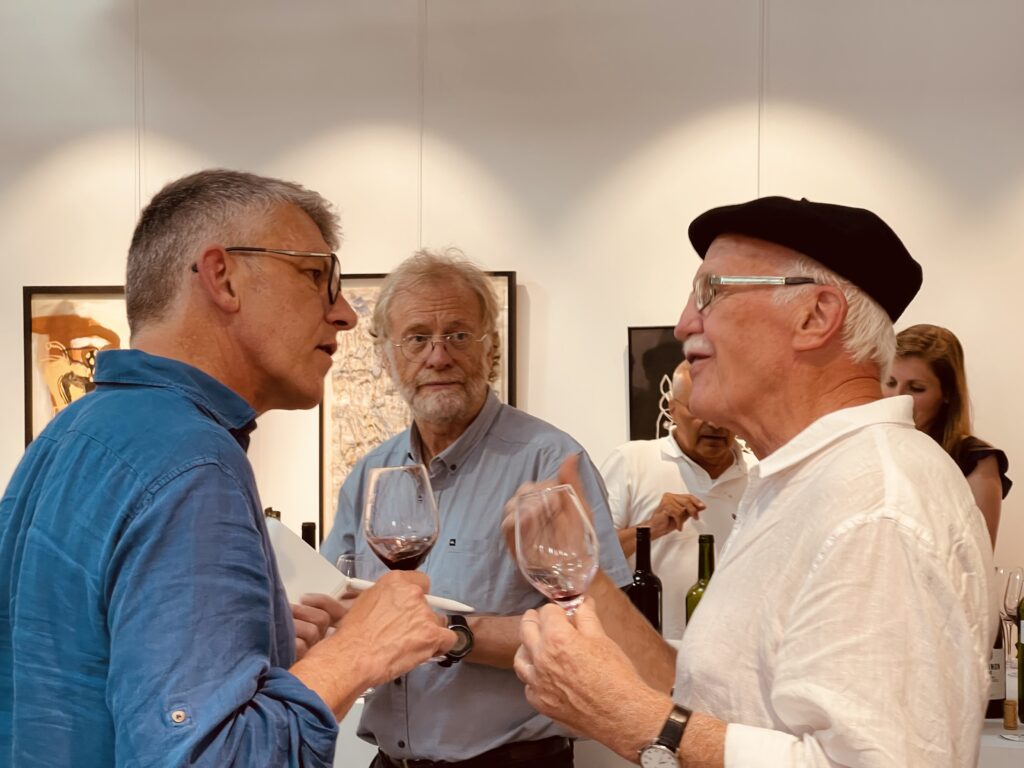
The Plaimont Co-op was established in 1979 – Pl for Plaisance, Ai for Aignan and Mont for St Mont. This co-op represents 98% of the St Mont appellation, and 55% of Madiran and Pacherenc du Vic Bilh: this equates to almost half of the Côtes de Gascogne PGI (they have 5300 hectares, 800 growers and 10 château, including Chateau de Sabazan, the Monestere de Saint Mont, The Cave de Condom). They have protected old vines by creating a vine conservatoire and by listing surviving vineyards, the aforementioned Pédebernade family vineyard is now an official Heritage Site. When the EU favoured grubbing up for cash, Plaimont paid their farmers to hold out. Old vines were preserved, propagated, vinified and drank. The results are pretty exciting – both in terms of taste and future potential (A wine made from the Pédebernade family vineyard, Né Sous X 2021 is listed in the tasting notes).
Plaimont is a thriving hub of learning and development – co-op land is rented out to younger members and strict mentorship given. Members are encouraged to compete for submission into the top blends – everyone has a stake. And all members must participate in promotional activities throughout the world – it’s very democratic, roughly a day per hectare per year – if they are truly dire at meeting and greeting (I asked) they can play to their strengths and swap duties. Members have seen their incomes rise consistently year upon year for decades – there is a real positivity and buzz about the place and a refusal to rest.
Olivier Bourdet-Pees, Diréctéur Generale Producteurs Plaimont is Dubosc’s successor, he tells me about the history of the Plaimont Co-op and the philosophy behind the movement, the grape Conservatory and André Debosc’s seminal influence. He also describes the experimental Sauvignon Blanc that we taste together live and that is about to go into commercial production (see tasting notes for tasting video)
Interview with Olivier Bourdet-Pees, Diréctéur Generale Producteurs Plaimont
Lisse Garnett: Why did you join Plaimont Olivier?
OBP: I entered Plaimont in the year 2008 because the job was done, I wanted something else huge for the region – it’s easier to believe in Plaimont now than 40 years ago. Sometimes we do things wrong because we have always done things a certain way. We need to be open minded, to invite in other ideas and opinions, to make wines that are interesting.
LG: But isn’t authenticity key, to make wines with a sense of place?
OBP: It’s not so easy when you go to London Wine Fair you will find 50 potential customers asking you, do you have Pinot Noir, because I am looking for Pinot Noir? We won’t do that I promise – it would be a copy – Burgundy is so expensive that people will buy the cheaper. We want to rediscover old varieties of apples, of tomatoes, you must the one with the taste coming from the local producer, this is the story we want to share. We are fighting against standardization of taste.
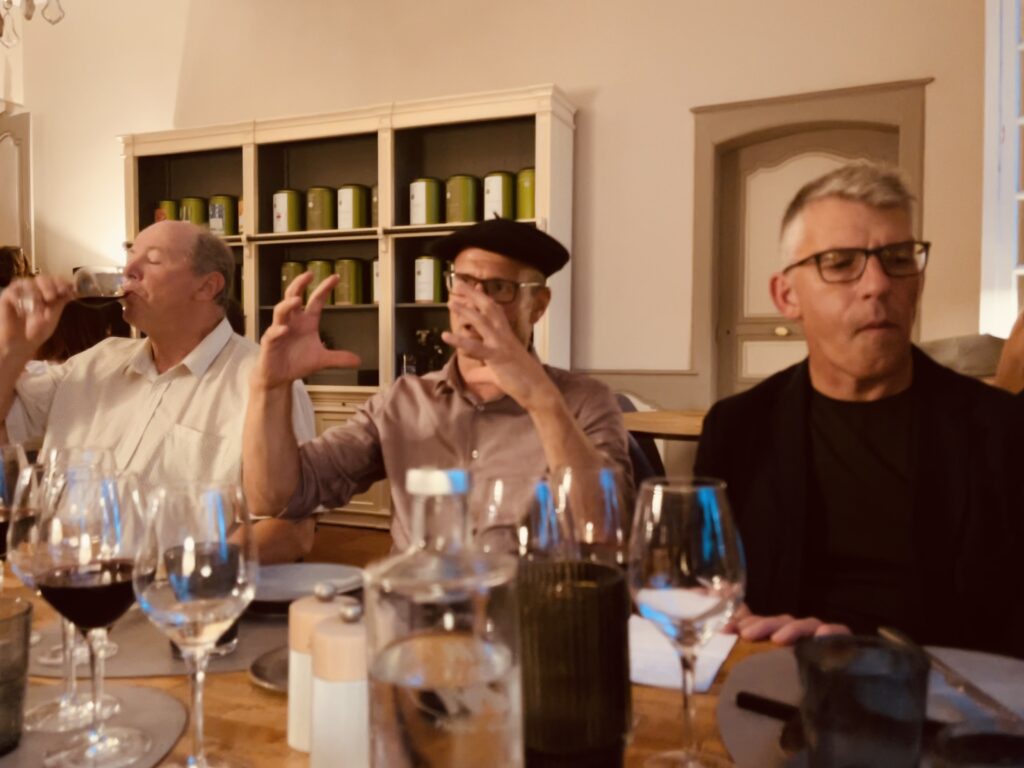
LG: Tell us the story of André Debosc.
OBP: He was 76, the very first to say to people here we have to work together, not to fight, you have to choose, we have to decide what we should do for the region, wine or Armagnac, we have to rebuild this appellation. It’s not a fight – we do know that if you believe in Armagnac, it’s difficult to swap and change – if wine is doing better make wine – if not make Armagnac, that is what we have tried to do, one or the other.
LG: Are there any other co-ops who have had the level of success you have in Plaimont?
OBP: Beginning from nothing I don’t think so. It started in 1969. 40 years ago I think we were producing the worst and the cheapest wines in France. The people were willing to change – from nothing, to build this co-op, there was nothing here, we were the worst. They were so desperate because they were nearly dead, there was nothing to preserve. They could see the evolution, the money, after ten years it was better, after 20 it was even better, they could see the evolution. Everyone is working to have more money of course. Money represents success.
LG: Why is the research side of what you do so important?
OBP: Research is fundamental to the project, if we don’t do it nobody will. We must do it for ourselves whereas in regions like Chablis have institutes to work on this. Here if we don’t do it no one will. It used to be that the best students went to Bordeaux – the worst came back – the best stayed in Bordeaux, now we have something to offer them here.
LG: How is it financed?
OBP: It is financed in many ways – some things for us are much easier than they are in say Chablis but some are much harder. The price of the vineyard is much cheaper so we have more money to put into research. Here land is approximately 20 000 euros per hectare. Here a guy in Saint Mont is earning around 7-8000 more a plot each year and you can pass it onto your children and if they want to buy more land it is possible for them. The energy is here – you can do it.
LG/ So that’s where the inspiration comes from – hope, the belief that you can do better, make something better to pass onto your children?
OBP: Andre Debosc showed people it was possible to believe in it when he entered Plaimont. There were people who believed in him and look at the results.
Tasting notes, viticulture & varieties..
The journey to bottle is long for rediscovered varieties, Oliver Bourdet talks us through the process and we taste a profoundly aromatic Sauvignon Blanc. This vine is now under cultivation following its chance discovery – a single vine in a sea of contrasting grapes..
The tasting notes include a wine made in tiny quantities from Heritage Vines in the Pédebernade family vineyard, the very first vineyard in France to become a designated national monument, Né Sous X 2021
Pédebernade Heritage Vineyard
We visited and tasted a wine made from Pédebernade Heritage Vineyard, the very first vineyard in France to be designated a historical monument. Two Tardif vines sit in 21 varieties, saved by the forward thinking Dubosc. The vines are in doubles, two to a post. The EU offered incentives for arracharge – ripping old, low production vines out of the ground. Dubosc had the foresite to pay people to keep them. Many families would have had vineyards like this one with which to make homemade wine – it is all the more fascinating for containing a mix of red and white and a Spanish vine – Morrastel and a Swiss variety – Miousat.
LG/ Conservatoire Plaimont, Né Sous X 2021
This wine is made up of Pédebernade 5, Dubosc 1, Dubosc 2, Chacolis (no relation to Basque Txakoli), Négret de Banhars. No alcohol listed but this is heady – Dark plum, puckered plum skin – blackcurrant, sour black cherry – sapid and tense – wild bramble fruit – intensely rich blackcurrant jam, chicory – blood – frangipane – satin like – silky on the tongue with a sublime super fruity yet savoury dense compact mid palate – textural with a delicious chewy tannic finish – young but this will get better and better, still a little disjointed but it’s coming… 92
L’Empriente de Saint Mont 2017
LG/Alcohol 13.5% Petit Corbu 20%, Grand Manseng 80%, Arrufiac (meaning rough/coarse) for spice. It’s a tannic and bitter grape, low in alcohol and it brings spice to the blend, more useful in hot years – it gives length, acidity and a flintiness to the wine. This grape originated in Gascony, more particularly St Mont and its only really found there to this day. The Producteurs Plaimont are responsible for saving this grape from extinction. 30% is aged in barrel, the rest in tanks for at least two years, then a further year in bottle. This wine is silky and viscous but light as a feather. Candied tangy lemon, white lily, fresh pineapple and a delicious salty white peppered minerality with that gorgeous endive bitterness and a lifted sapid homemade lemonade finish – long and luscious. Absolutely delicious 93
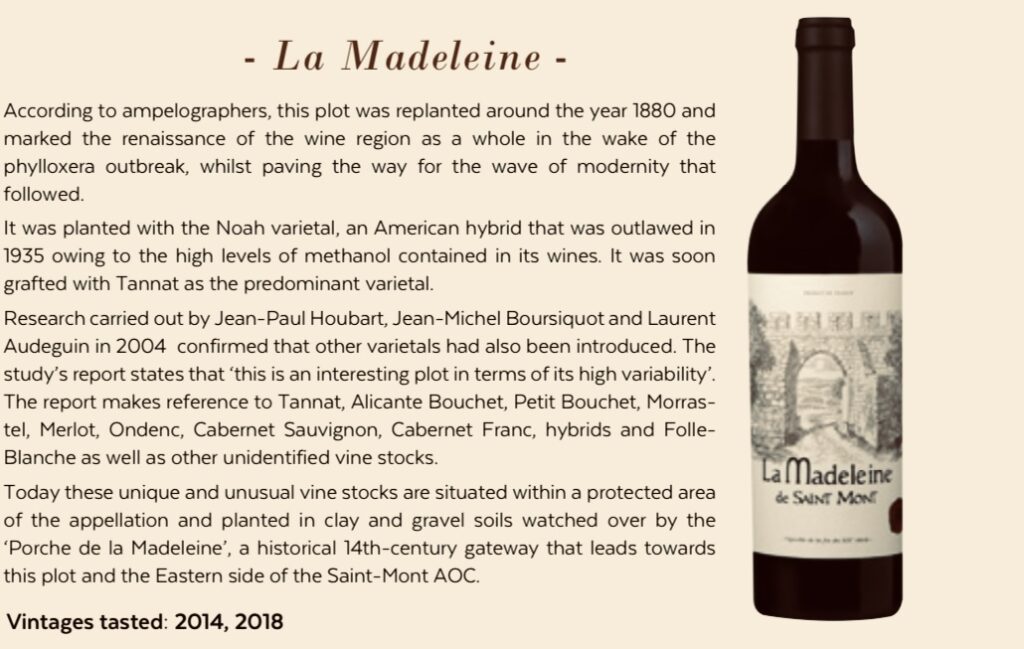
2018 La Madeleine de St Mont, Plaimont
LG/ 14% Alcohol. Sired from a mad old monastic plot, peppered with pilgrim’s ghosts – an ancient field blend of predominantly Tannat but others too, Alicante Bouchet, Petit Bouchet, Merlot, Cab Franc (see article above). This is really special – dense, deep, black, spicy yet fresh and rich in gnarly time-served Tolkienesque tannins. Mouth-stainingly fruity, conjures brambles, plum, prune, cherry – elegantly culminates in a silky-smooth finish. Will last for millennia 96
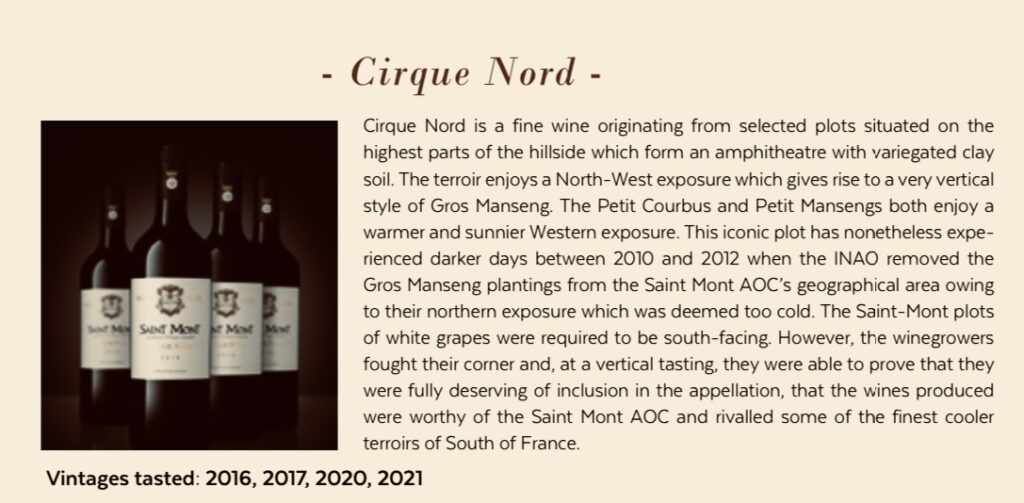
Cirque Nord Grande Cuvee 2014 Saint Mont, France
JG/ (Tasted in 2020) 13.5% alcohol. This is the debut vintage. Toast, spice and honey on the nose with some marmalade notes. The palate has amazing complexity, with apricot, peach, spice and nuts. This is so complex and has begun to develop in a really interesting way, with some savoury truffle notes as well as the dried citrus fruit and fine toastiness. Such a remarkable wine, still tasting fresh and youthful. 95/100 (£49.99 Gusto Wines)
Cirque Nord Grande Cuvee 2016 Saint Mont, France
LG/14% Alcohol. 70% Gros Manseng, 10% Petit Corbus, 20% Petit Manseng. 12 months on lees. Sublimely textural, complex and layered – weighted silk: cool and heavy on the tongue. Oily almond, waxy nuts: rich and full – glides: supplies an entrée of super sapid, sour lemon pips – then gorgeous, rich and weighty – pear, golden apple, peach – a savoury hint of almond oil, toast, saline, laurel and bitter endive. It is fresh, vivacious, rich and cool and the top notes are tinged with pineapple and sweet honeyed blossom – leaving a savoury nutty finish. War and Peace Long 94
JG/(Tasted in 2020) 14% alcohol. Golden in colour, this has aromas of honey and nuts with some peachy richness. The palate is broad and rich with some hints of coconut as well as powerful citrus and pineapple notes, with a warm spiciness. There’s good acidity here and some harmony, with a bit of oak showing. This has a long spicy finish. Massive potential for future development. 94/100
Cirque Nord Grande Cuvee 2017 Saint Mont, France
LG/ 14% alcohol. 50% Gros Manseng, 25% Petit Corbu, 25% Petit Manseng. Sweetly fragranced with florals, sweet blossom, roasted pineapple, honey, pineapple juice and lemon sherbet pips. A delicious savoury bitter tinge of walnut skin,toast, white pepper and endive, saline and sour lemon. Sapid, smooth, silky and dry 94
JG/(Tasted in 2020) 14% alcohol. A wonderful year for whites. 50% Gros Manseng, 25% Petit Corbu, 25% Petit Manseng. Golden colour. This is intense and vivid with honey, spice and nuts, as well as some pineapple and lemon notes. It’s a rounded wine, but also very fresh, with a touch of marmalade and spice. Powerful and complex with high acid on the finish. Juicy with amazing intensity of flavour and nice complexity. Such a distinctive wine. 94/100
Cirque Nord Grande Cuvee 2020 Saint Mont, France
LG/ 14% alcohol. 50% Gros Manseng, 25% Petit Corbu, 25% Petit Manseng.Lemon, lime, lemon verbena and laurel, underripe pineapple and salted lemon pips. Silky, textural and layered. Bitter endive and saline on the long savoury finish 94
WILD LAMBRUSQUE VINE
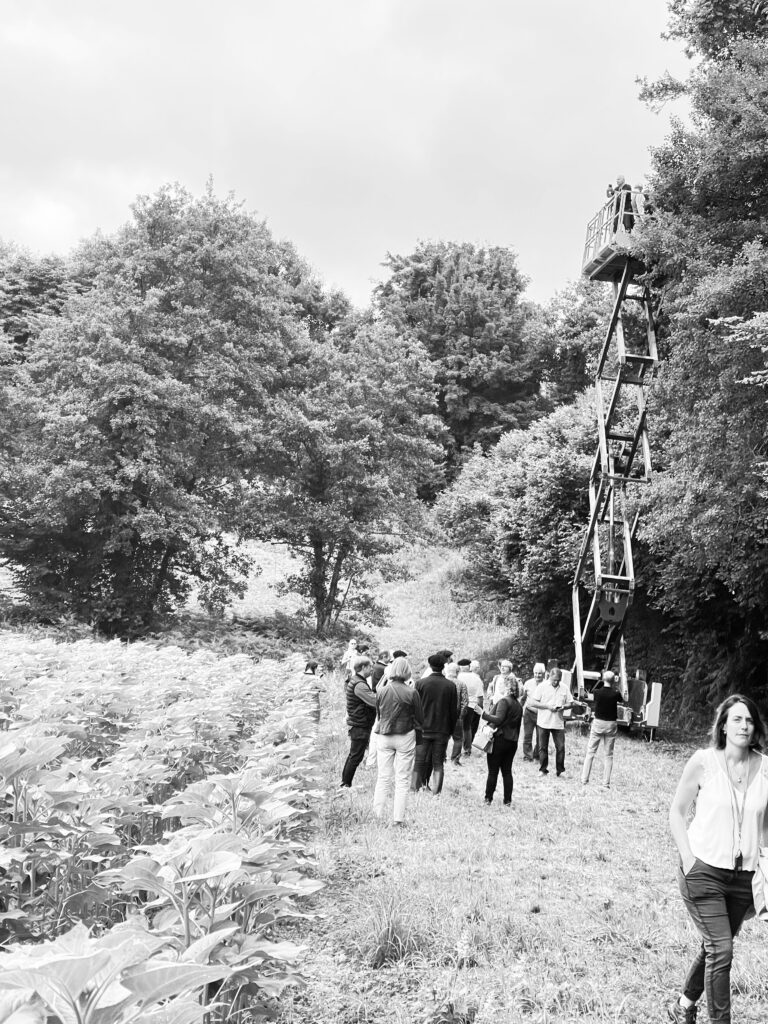
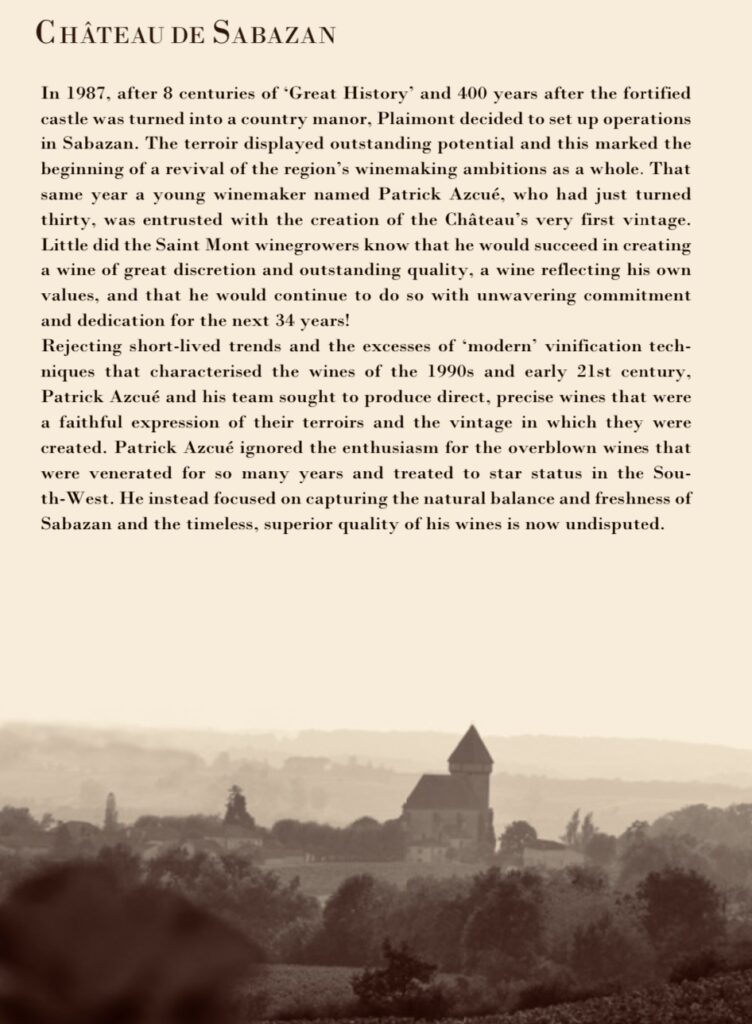
Plaimont 2018 Château de Sabazan (St Mont)
LG/14% Alcohol. A fragrant blend of old vine Tannat, Pinenc, Cabernet Franc, Cabernet Sauvignon grown on extremely sandy soils without chemicals. Elegant, round, structured, dense and fresh, mulberry and savoury bitter endive, a delicious chewy dry tannin and sapid acidity. Already gorgeous – 93
For further tasting notes – head to Jamies excellent earlier piece…
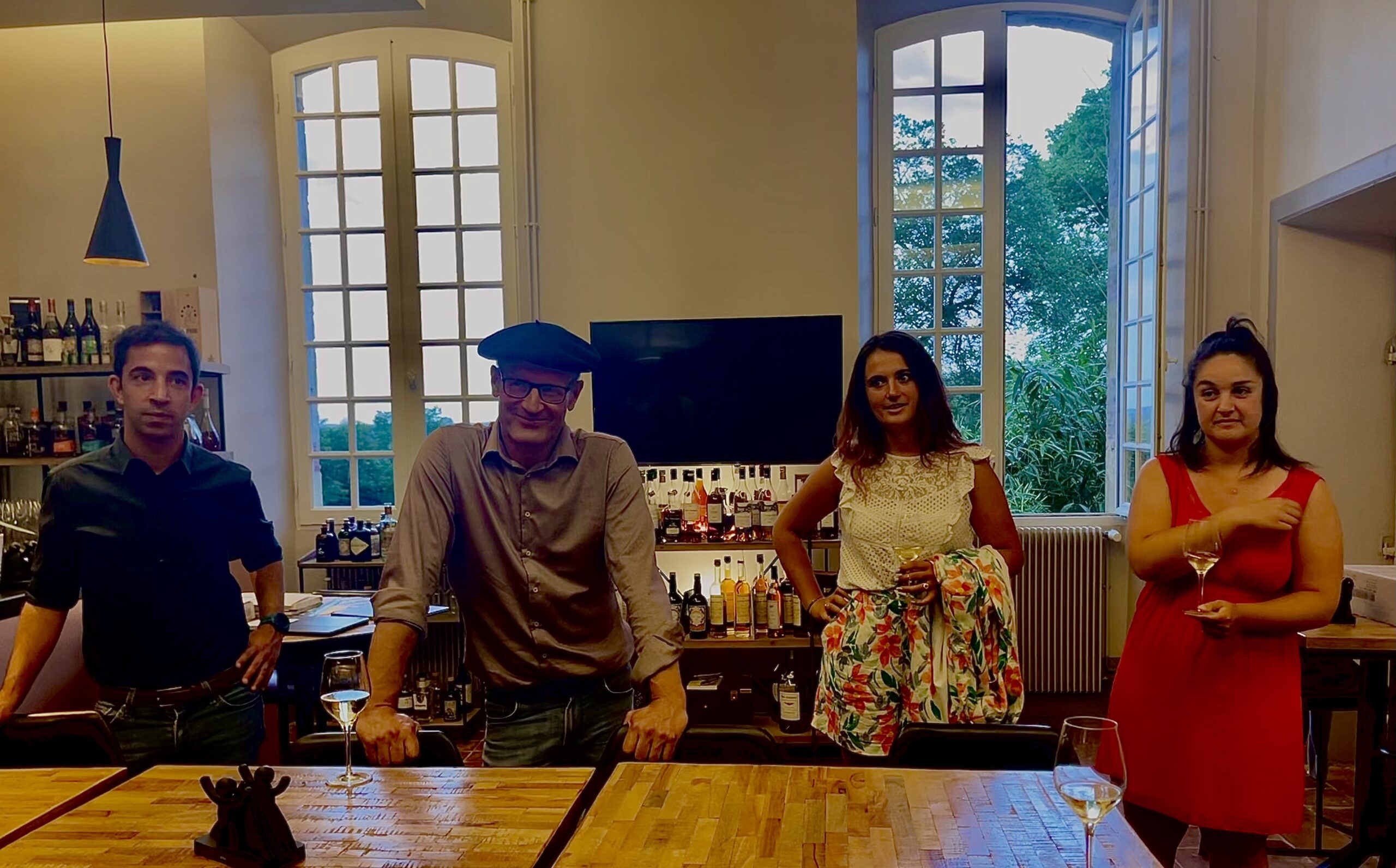
The Kitchen of Monastére de Saint Mont 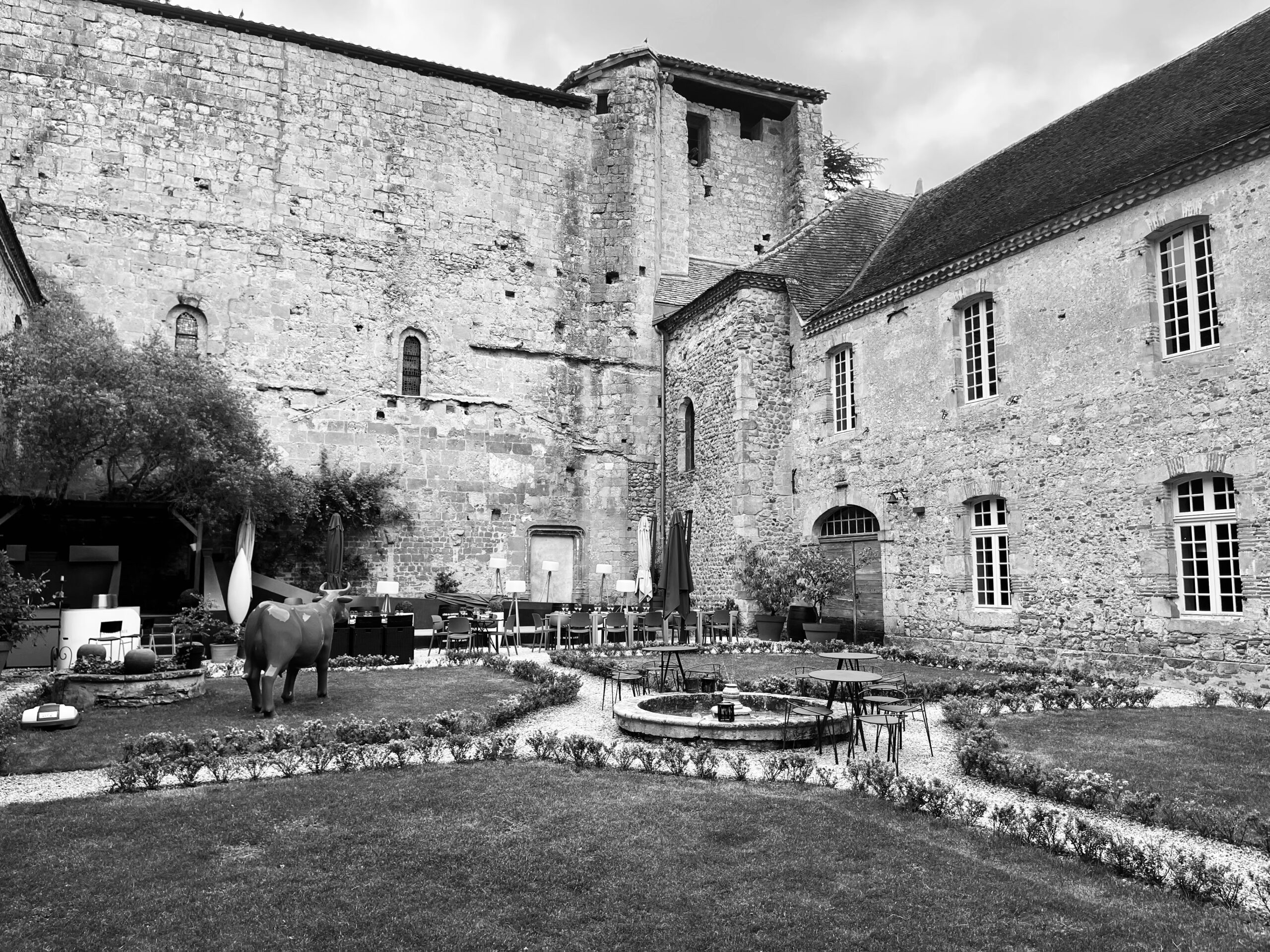
The Monastére de Saint Mont inner courtyard 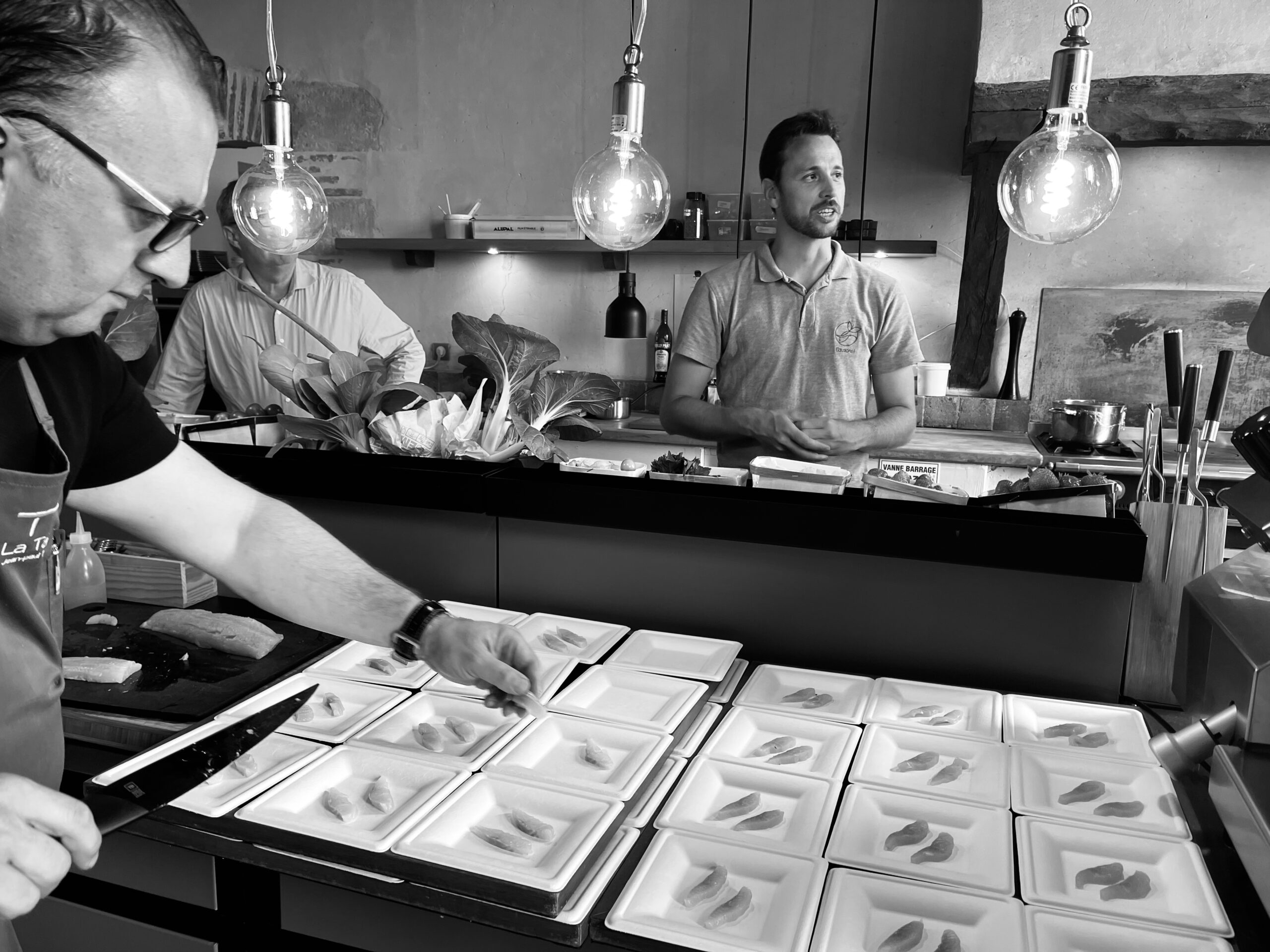
The talented Chef of The Monastére de Saint Mont, Michelin star ready 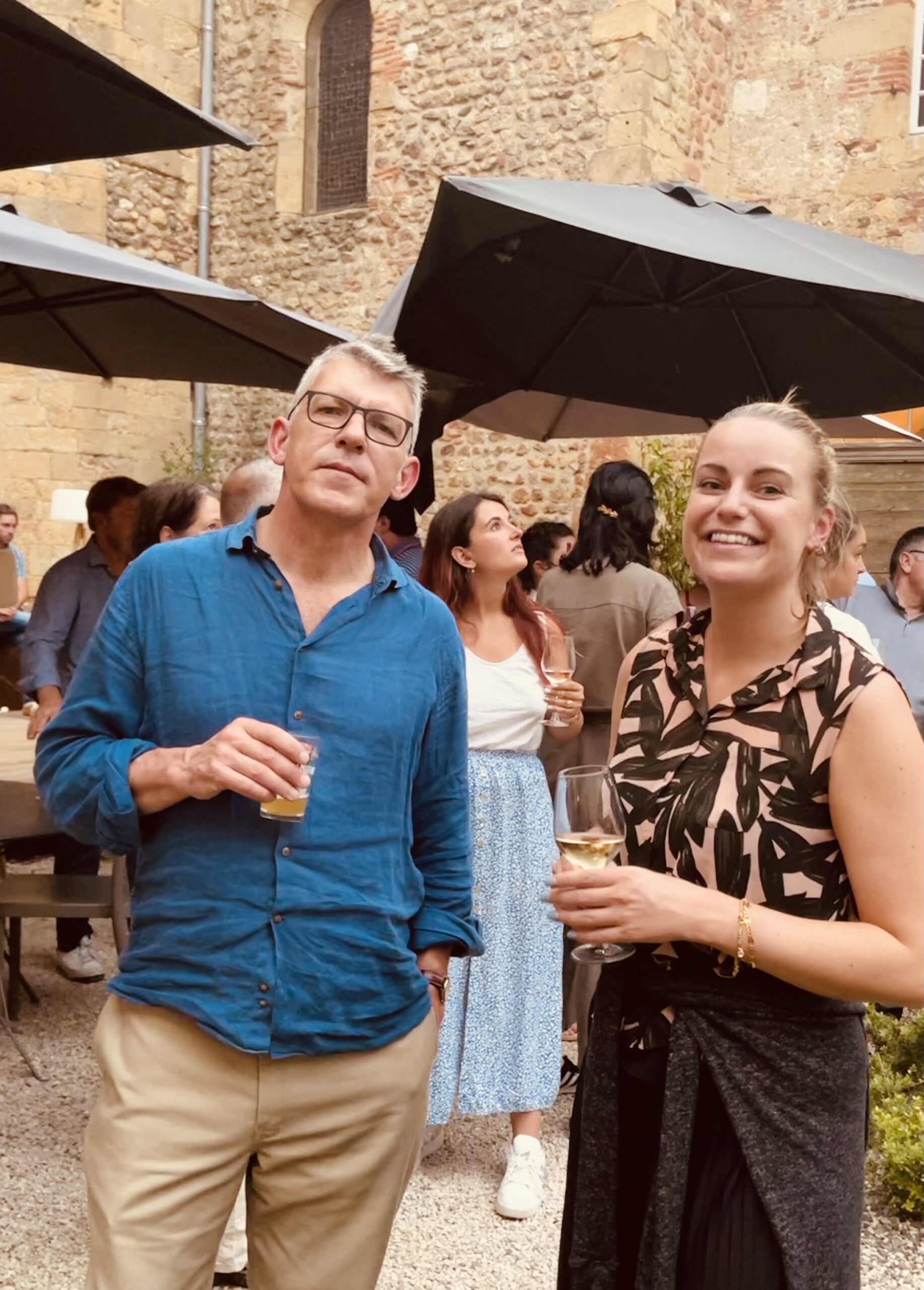
Little Wines Christina Rasmussen, wine writer and Adam Lechmere 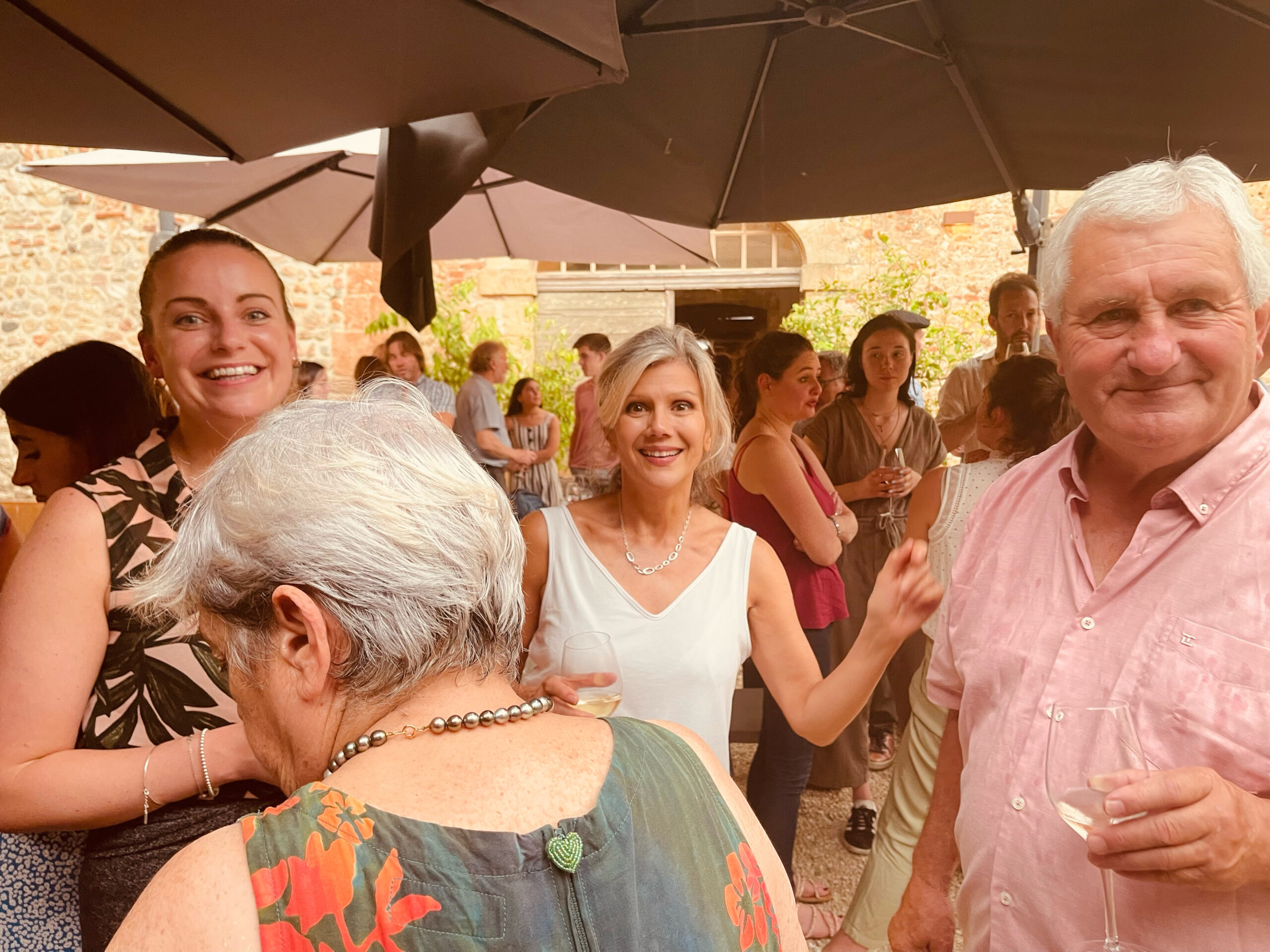
The charmingly indomitable Susy Harris of Westbury Communications 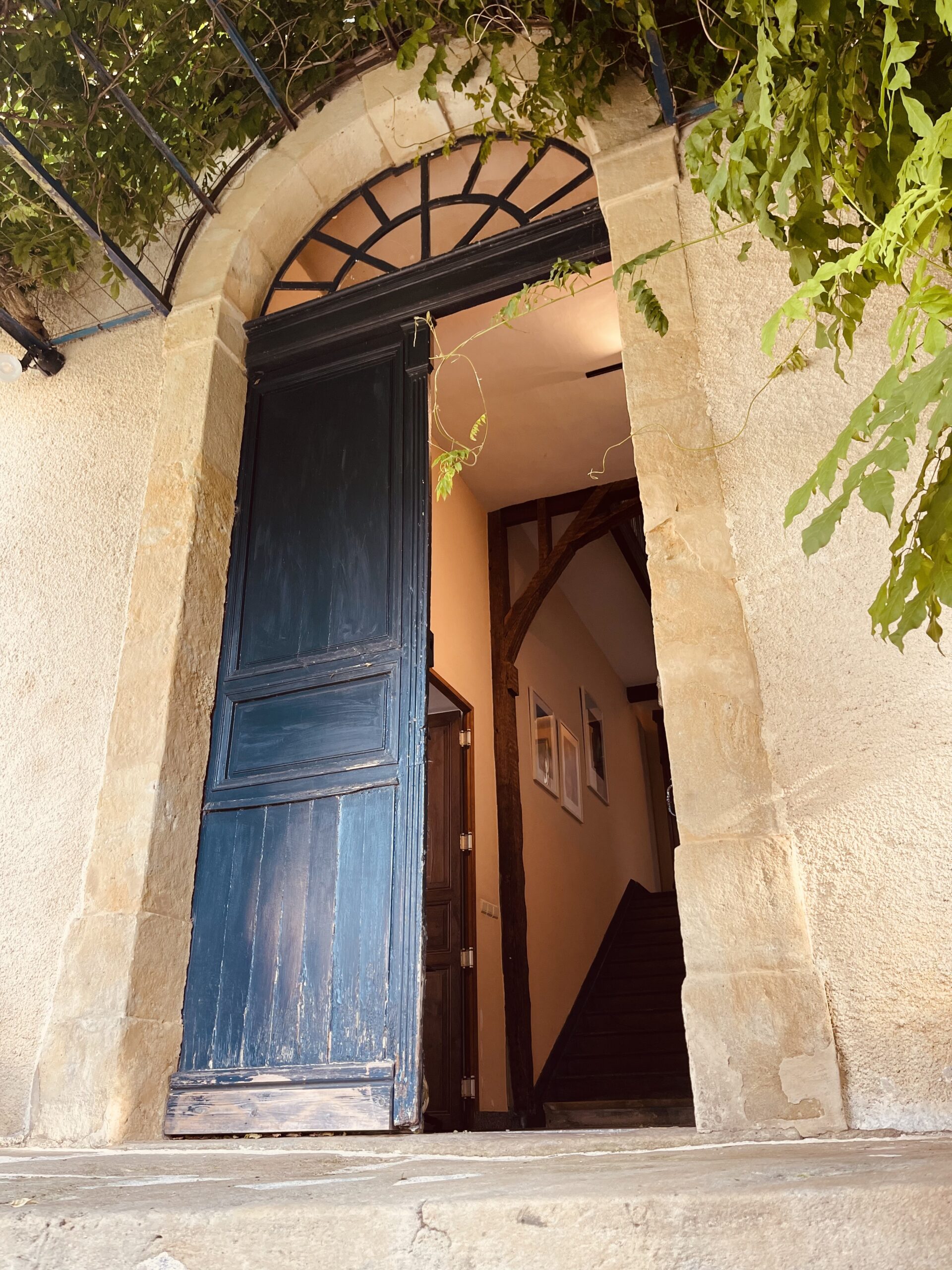
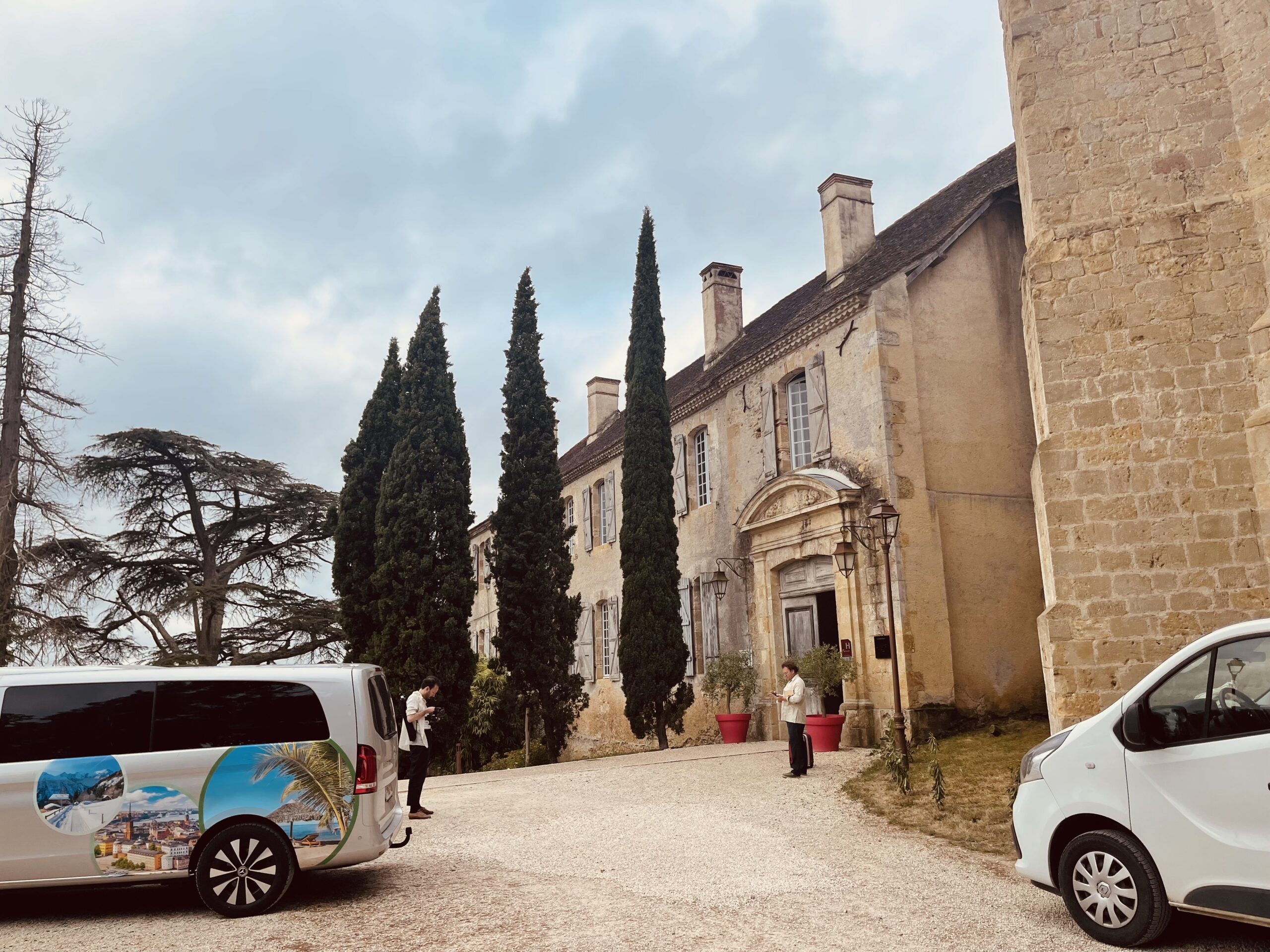
The eleventh century Monastére de Saint Mont, surrounded by vines, established by monks and owned by the Plaimont co-op (has an exquisite restaurant and hotel)
Tardif
Plaimont’s discovery of Tardif N in Historical Monument designated vineyards, some twenty years ago has caused considerable excitement within the co-op – late ripening – as the name suggests and characterised by small, densely clustered grapes that are intensely coloured and rich in polyphenols and a distinctive peppery note. This variety gets its peppery character from the compound ROTUNDONE, also notable in Syrah and peppercorns, identified by the Australian Wine Research Institute (AWRI) in 2005. The INAO have now agreed to include Tardif as a varietal of interest with a view to adaptation.
